Analysis of Leadership and Management Practices at Tata Steel (Corus)
VerifiedAdded on 2021/02/21
|17
|5489
|24
Report
AI Summary
This report provides a detailed analysis of leadership and management practices within Corus, a steel and metal manufacturing company acquired by Tata Steel. The introduction outlines the scope, focusing on the roles and characteristics of leaders and managers, their functions in different situations, and the application of various leadership theories and models, including situational, system, and contingency approaches. The report delves into the key approaches to operation management and evaluates the importance of operations management in achieving business objectives. Furthermore, it assesses the factors impacting operational management and decision-making by leaders and managers. The report differentiates between modern leaders and managers, outlining their vision-oriented versus process-oriented approaches, and contrasting their personal characteristics, relationships, and outcomes. It further examines how leaders and managers adapt their roles based on situational contexts, such as implementing new tasks, enhancing brand image, and arranging employee training programs. The report highlights the situational leadership theory, including the leader's roles in telling, selling, advising, and delegating. It also explores the system leadership theory and provides strengths and weaknesses of the theories. The conclusion summarizes the key findings and implications for effective leadership and management within the organization.
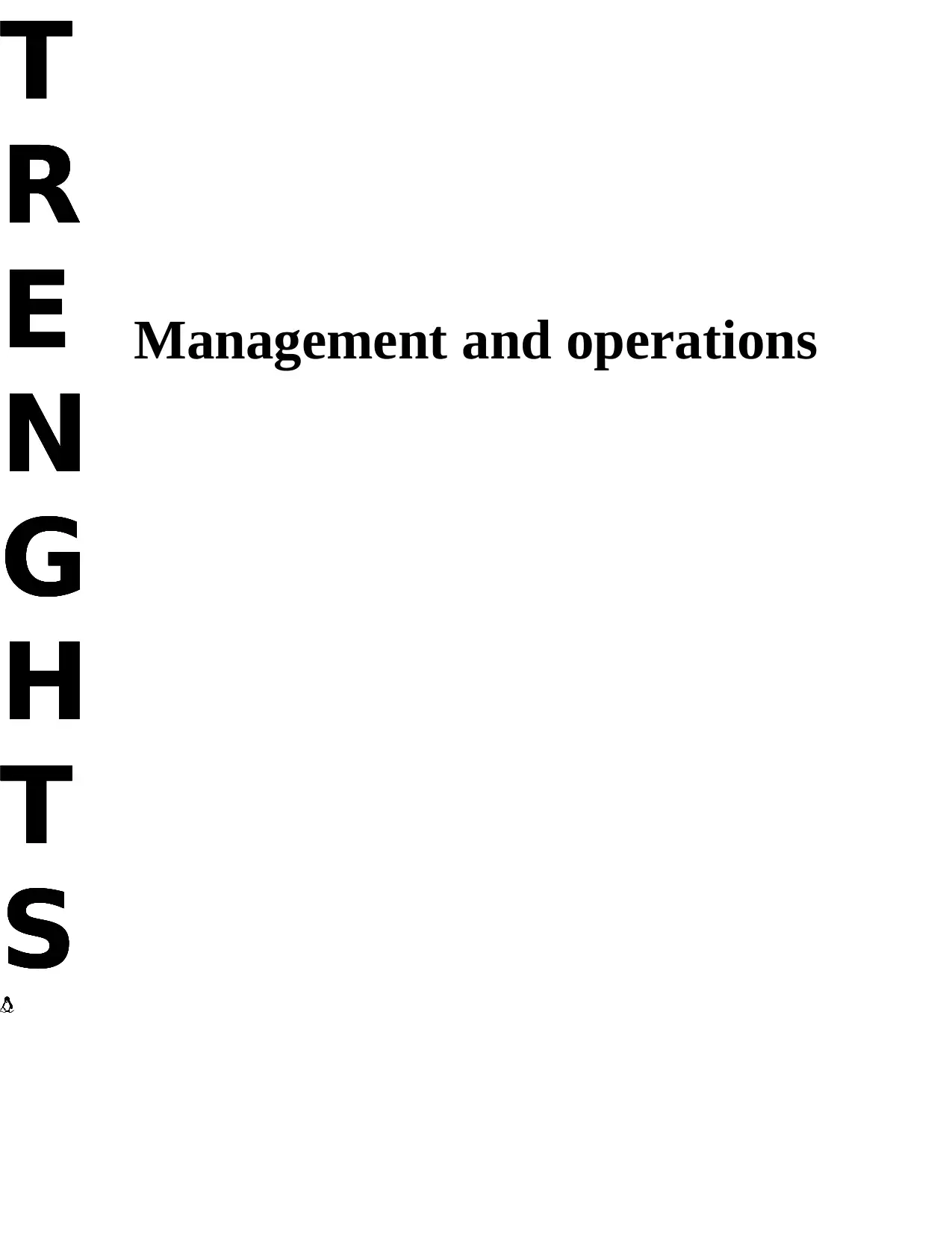
Management and operations
T
R
E
N
G
H
T
S
E
T
R
E
N
G
H
T
S
E
T
R
E
N
G
H
T
S
E
T
R
E
N
G
H
T
S
E
T
R
E
N
G
H
T
S
E
T
R
E
N
G
H
T
S
E
T
R
E
N
G
H
T
S
E
T
R
E
N
G
H
T
S
E
T
R
E
N
G
H
T
S
E
T
R
E
N
G
H
T
S
E
Paraphrase This Document
Need a fresh take? Get an instant paraphrase of this document with our AI Paraphraser
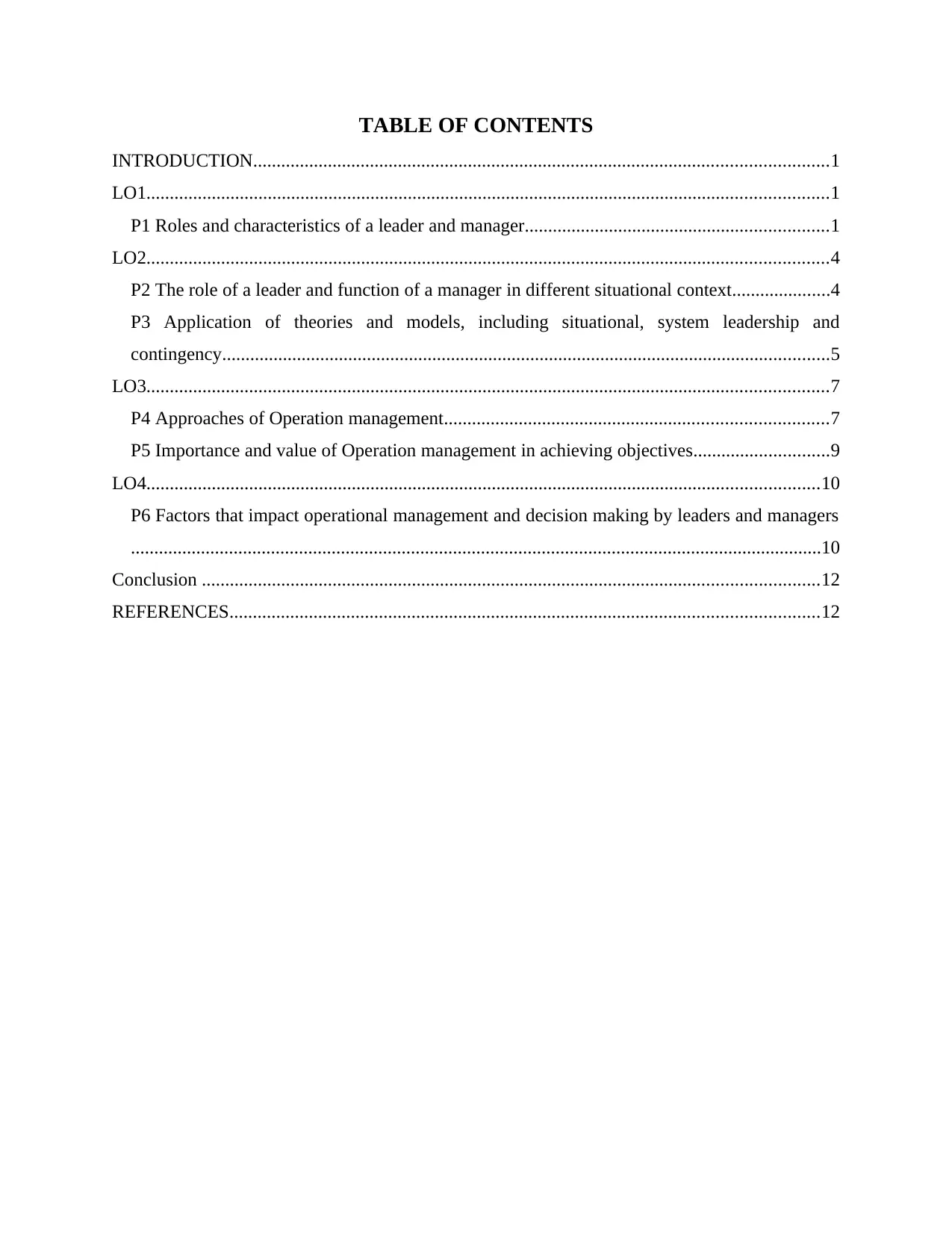
TABLE OF CONTENTS
INTRODUCTION...........................................................................................................................1
LO1..................................................................................................................................................1
P1 Roles and characteristics of a leader and manager.................................................................1
LO2..................................................................................................................................................4
P2 The role of a leader and function of a manager in different situational context.....................4
P3 Application of theories and models, including situational, system leadership and
contingency..................................................................................................................................5
LO3..................................................................................................................................................7
P4 Approaches of Operation management..................................................................................7
P5 Importance and value of Operation management in achieving objectives.............................9
LO4................................................................................................................................................10
P6 Factors that impact operational management and decision making by leaders and managers
....................................................................................................................................................10
Conclusion ....................................................................................................................................12
REFERENCES..............................................................................................................................12
INTRODUCTION...........................................................................................................................1
LO1..................................................................................................................................................1
P1 Roles and characteristics of a leader and manager.................................................................1
LO2..................................................................................................................................................4
P2 The role of a leader and function of a manager in different situational context.....................4
P3 Application of theories and models, including situational, system leadership and
contingency..................................................................................................................................5
LO3..................................................................................................................................................7
P4 Approaches of Operation management..................................................................................7
P5 Importance and value of Operation management in achieving objectives.............................9
LO4................................................................................................................................................10
P6 Factors that impact operational management and decision making by leaders and managers
....................................................................................................................................................10
Conclusion ....................................................................................................................................12
REFERENCES..............................................................................................................................12
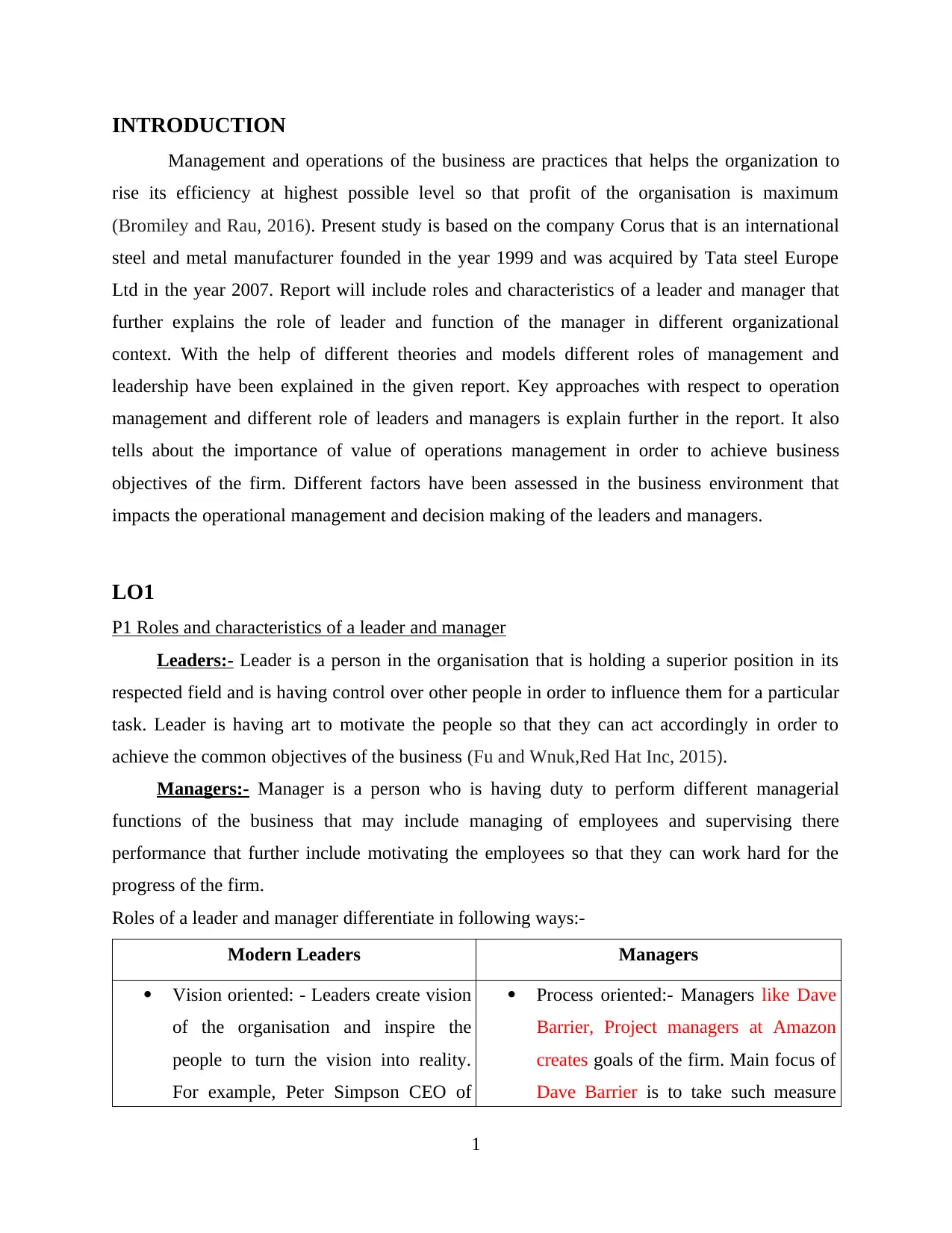
INTRODUCTION
Management and operations of the business are practices that helps the organization to
rise its efficiency at highest possible level so that profit of the organisation is maximum
(Bromiley and Rau, 2016). Present study is based on the company Corus that is an international
steel and metal manufacturer founded in the year 1999 and was acquired by Tata steel Europe
Ltd in the year 2007. Report will include roles and characteristics of a leader and manager that
further explains the role of leader and function of the manager in different organizational
context. With the help of different theories and models different roles of management and
leadership have been explained in the given report. Key approaches with respect to operation
management and different role of leaders and managers is explain further in the report. It also
tells about the importance of value of operations management in order to achieve business
objectives of the firm. Different factors have been assessed in the business environment that
impacts the operational management and decision making of the leaders and managers.
LO1
P1 Roles and characteristics of a leader and manager
Leaders:- Leader is a person in the organisation that is holding a superior position in its
respected field and is having control over other people in order to influence them for a particular
task. Leader is having art to motivate the people so that they can act accordingly in order to
achieve the common objectives of the business (Fu and Wnuk,Red Hat Inc, 2015).
Managers:- Manager is a person who is having duty to perform different managerial
functions of the business that may include managing of employees and supervising there
performance that further include motivating the employees so that they can work hard for the
progress of the firm.
Roles of a leader and manager differentiate in following ways:-
Modern Leaders Managers
Vision oriented: - Leaders create vision
of the organisation and inspire the
people to turn the vision into reality.
For example, Peter Simpson CEO of
Process oriented:- Managers like Dave
Barrier, Project managers at Amazon
creates goals of the firm. Main focus of
Dave Barrier is to take such measure
1
Management and operations of the business are practices that helps the organization to
rise its efficiency at highest possible level so that profit of the organisation is maximum
(Bromiley and Rau, 2016). Present study is based on the company Corus that is an international
steel and metal manufacturer founded in the year 1999 and was acquired by Tata steel Europe
Ltd in the year 2007. Report will include roles and characteristics of a leader and manager that
further explains the role of leader and function of the manager in different organizational
context. With the help of different theories and models different roles of management and
leadership have been explained in the given report. Key approaches with respect to operation
management and different role of leaders and managers is explain further in the report. It also
tells about the importance of value of operations management in order to achieve business
objectives of the firm. Different factors have been assessed in the business environment that
impacts the operational management and decision making of the leaders and managers.
LO1
P1 Roles and characteristics of a leader and manager
Leaders:- Leader is a person in the organisation that is holding a superior position in its
respected field and is having control over other people in order to influence them for a particular
task. Leader is having art to motivate the people so that they can act accordingly in order to
achieve the common objectives of the business (Fu and Wnuk,Red Hat Inc, 2015).
Managers:- Manager is a person who is having duty to perform different managerial
functions of the business that may include managing of employees and supervising there
performance that further include motivating the employees so that they can work hard for the
progress of the firm.
Roles of a leader and manager differentiate in following ways:-
Modern Leaders Managers
Vision oriented: - Leaders create vision
of the organisation and inspire the
people to turn the vision into reality.
For example, Peter Simpson CEO of
Process oriented:- Managers like Dave
Barrier, Project managers at Amazon
creates goals of the firm. Main focus of
Dave Barrier is to take such measure
1
⊘ This is a preview!⊘
Do you want full access?
Subscribe today to unlock all pages.

Trusted by 1+ million students worldwide
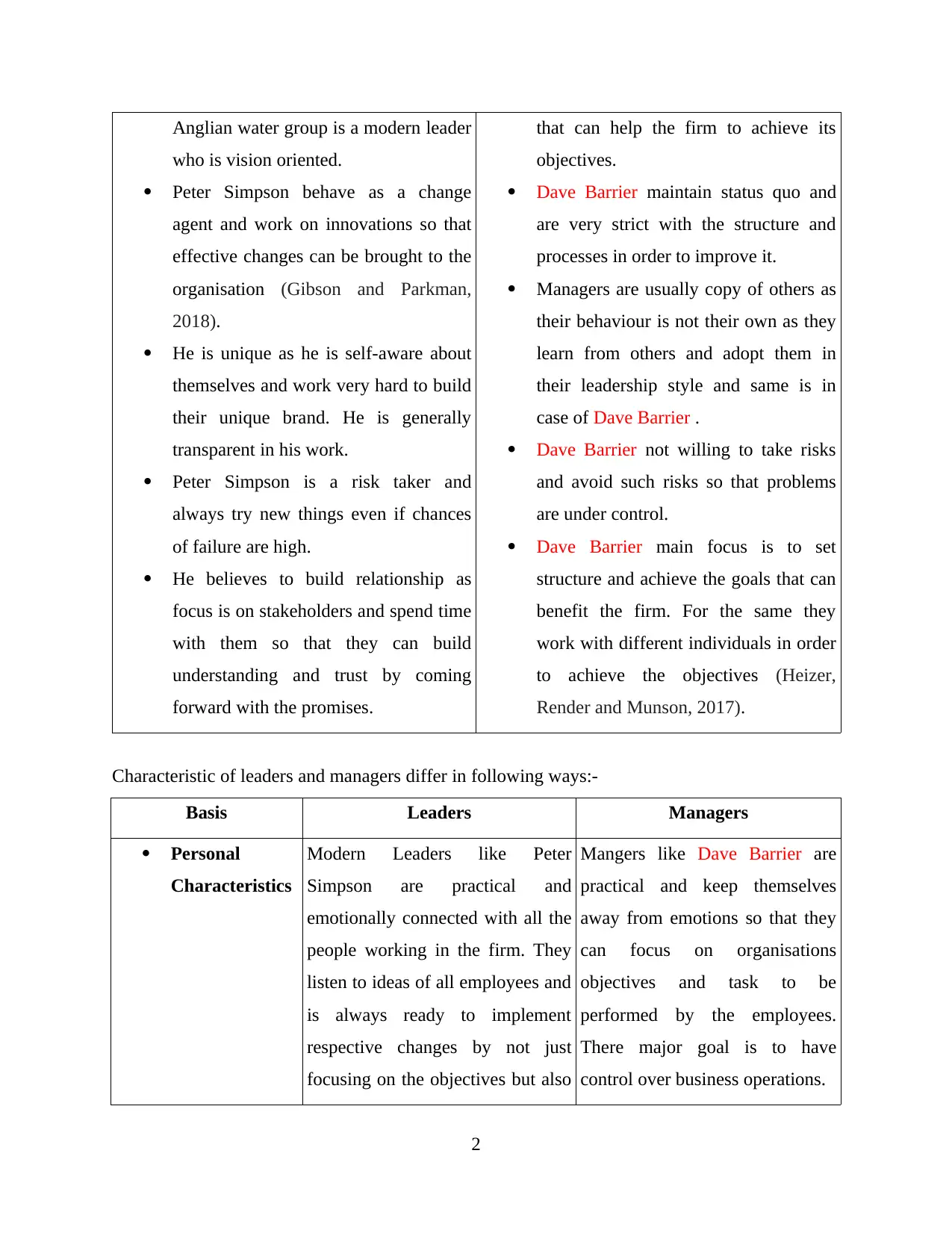
Anglian water group is a modern leader
who is vision oriented.
Peter Simpson behave as a change
agent and work on innovations so that
effective changes can be brought to the
organisation (Gibson and Parkman,
2018).
He is unique as he is self-aware about
themselves and work very hard to build
their unique brand. He is generally
transparent in his work.
Peter Simpson is a risk taker and
always try new things even if chances
of failure are high.
He believes to build relationship as
focus is on stakeholders and spend time
with them so that they can build
understanding and trust by coming
forward with the promises.
that can help the firm to achieve its
objectives.
Dave Barrier maintain status quo and
are very strict with the structure and
processes in order to improve it.
Managers are usually copy of others as
their behaviour is not their own as they
learn from others and adopt them in
their leadership style and same is in
case of Dave Barrier .
Dave Barrier not willing to take risks
and avoid such risks so that problems
are under control.
Dave Barrier main focus is to set
structure and achieve the goals that can
benefit the firm. For the same they
work with different individuals in order
to achieve the objectives (Heizer,
Render and Munson, 2017).
Characteristic of leaders and managers differ in following ways:-
Basis Leaders Managers
Personal
Characteristics
Modern Leaders like Peter
Simpson are practical and
emotionally connected with all the
people working in the firm. They
listen to ideas of all employees and
is always ready to implement
respective changes by not just
focusing on the objectives but also
Mangers like Dave Barrier are
practical and keep themselves
away from emotions so that they
can focus on organisations
objectives and task to be
performed by the employees.
There major goal is to have
control over business operations.
2
who is vision oriented.
Peter Simpson behave as a change
agent and work on innovations so that
effective changes can be brought to the
organisation (Gibson and Parkman,
2018).
He is unique as he is self-aware about
themselves and work very hard to build
their unique brand. He is generally
transparent in his work.
Peter Simpson is a risk taker and
always try new things even if chances
of failure are high.
He believes to build relationship as
focus is on stakeholders and spend time
with them so that they can build
understanding and trust by coming
forward with the promises.
that can help the firm to achieve its
objectives.
Dave Barrier maintain status quo and
are very strict with the structure and
processes in order to improve it.
Managers are usually copy of others as
their behaviour is not their own as they
learn from others and adopt them in
their leadership style and same is in
case of Dave Barrier .
Dave Barrier not willing to take risks
and avoid such risks so that problems
are under control.
Dave Barrier main focus is to set
structure and achieve the goals that can
benefit the firm. For the same they
work with different individuals in order
to achieve the objectives (Heizer,
Render and Munson, 2017).
Characteristic of leaders and managers differ in following ways:-
Basis Leaders Managers
Personal
Characteristics
Modern Leaders like Peter
Simpson are practical and
emotionally connected with all the
people working in the firm. They
listen to ideas of all employees and
is always ready to implement
respective changes by not just
focusing on the objectives but also
Mangers like Dave Barrier are
practical and keep themselves
away from emotions so that they
can focus on organisations
objectives and task to be
performed by the employees.
There major goal is to have
control over business operations.
2
Paraphrase This Document
Need a fresh take? Get an instant paraphrase of this document with our AI Paraphraser
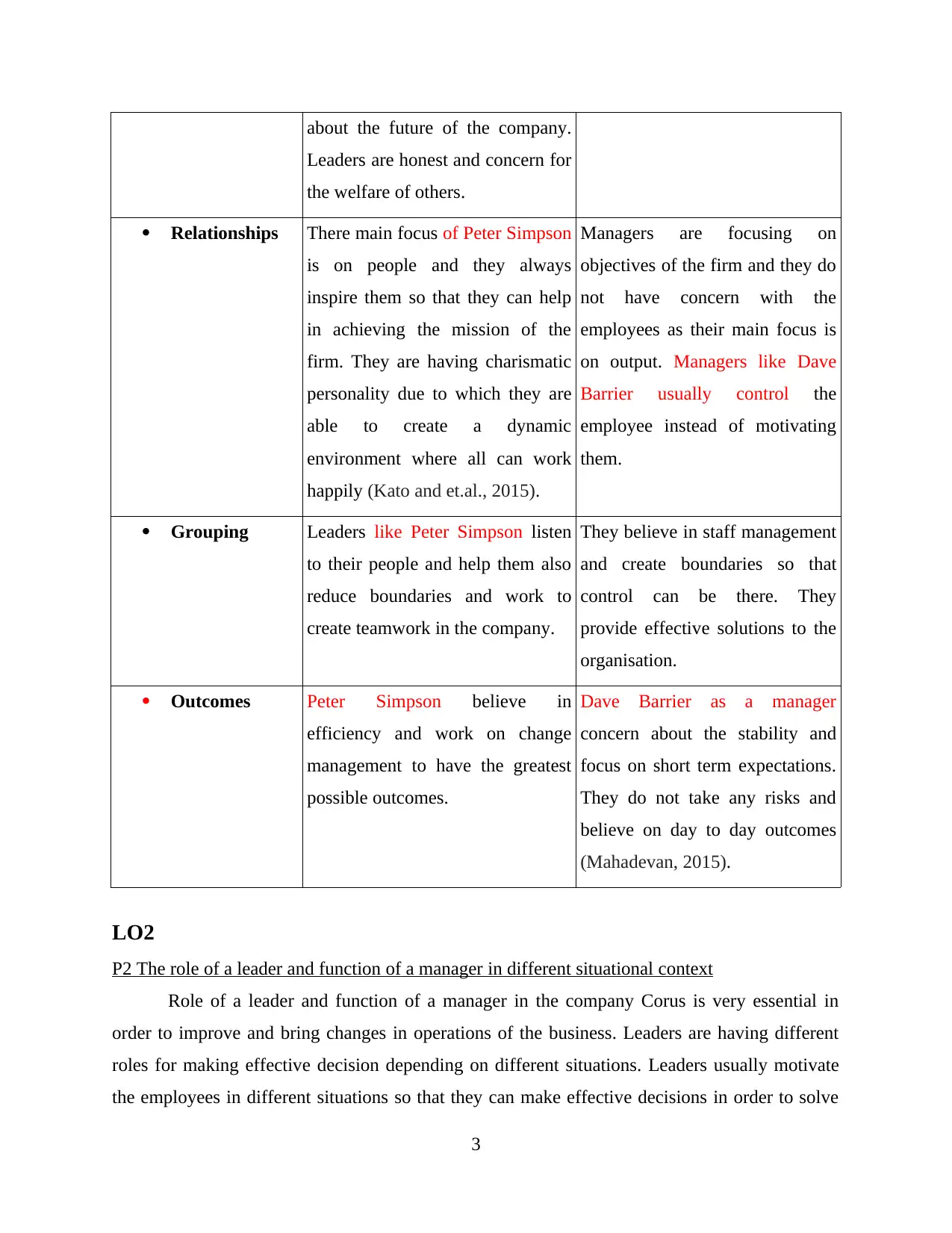
about the future of the company.
Leaders are honest and concern for
the welfare of others.
Relationships There main focus of Peter Simpson
is on people and they always
inspire them so that they can help
in achieving the mission of the
firm. They are having charismatic
personality due to which they are
able to create a dynamic
environment where all can work
happily (Kato and et.al., 2015).
Managers are focusing on
objectives of the firm and they do
not have concern with the
employees as their main focus is
on output. Managers like Dave
Barrier usually control the
employee instead of motivating
them.
Grouping Leaders like Peter Simpson listen
to their people and help them also
reduce boundaries and work to
create teamwork in the company.
They believe in staff management
and create boundaries so that
control can be there. They
provide effective solutions to the
organisation.
Outcomes Peter Simpson believe in
efficiency and work on change
management to have the greatest
possible outcomes.
Dave Barrier as a manager
concern about the stability and
focus on short term expectations.
They do not take any risks and
believe on day to day outcomes
(Mahadevan, 2015).
LO2
P2 The role of a leader and function of a manager in different situational context
Role of a leader and function of a manager in the company Corus is very essential in
order to improve and bring changes in operations of the business. Leaders are having different
roles for making effective decision depending on different situations. Leaders usually motivate
the employees in different situations so that they can make effective decisions in order to solve
3
Leaders are honest and concern for
the welfare of others.
Relationships There main focus of Peter Simpson
is on people and they always
inspire them so that they can help
in achieving the mission of the
firm. They are having charismatic
personality due to which they are
able to create a dynamic
environment where all can work
happily (Kato and et.al., 2015).
Managers are focusing on
objectives of the firm and they do
not have concern with the
employees as their main focus is
on output. Managers like Dave
Barrier usually control the
employee instead of motivating
them.
Grouping Leaders like Peter Simpson listen
to their people and help them also
reduce boundaries and work to
create teamwork in the company.
They believe in staff management
and create boundaries so that
control can be there. They
provide effective solutions to the
organisation.
Outcomes Peter Simpson believe in
efficiency and work on change
management to have the greatest
possible outcomes.
Dave Barrier as a manager
concern about the stability and
focus on short term expectations.
They do not take any risks and
believe on day to day outcomes
(Mahadevan, 2015).
LO2
P2 The role of a leader and function of a manager in different situational context
Role of a leader and function of a manager in the company Corus is very essential in
order to improve and bring changes in operations of the business. Leaders are having different
roles for making effective decision depending on different situations. Leaders usually motivate
the employees in different situations so that they can make effective decisions in order to solve
3
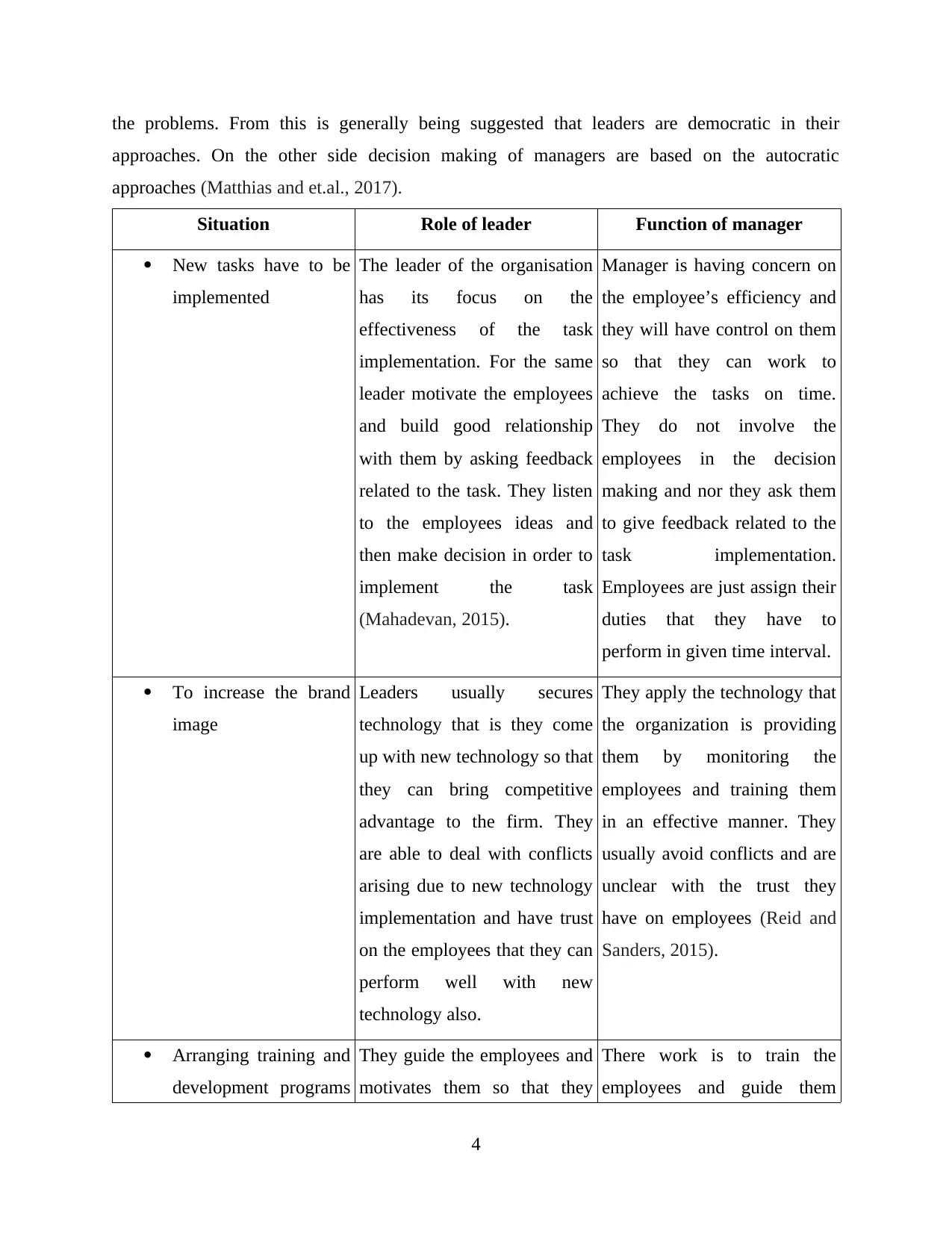
the problems. From this is generally being suggested that leaders are democratic in their
approaches. On the other side decision making of managers are based on the autocratic
approaches (Matthias and et.al., 2017).
Situation Role of leader Function of manager
New tasks have to be
implemented
The leader of the organisation
has its focus on the
effectiveness of the task
implementation. For the same
leader motivate the employees
and build good relationship
with them by asking feedback
related to the task. They listen
to the employees ideas and
then make decision in order to
implement the task
(Mahadevan, 2015).
Manager is having concern on
the employee’s efficiency and
they will have control on them
so that they can work to
achieve the tasks on time.
They do not involve the
employees in the decision
making and nor they ask them
to give feedback related to the
task implementation.
Employees are just assign their
duties that they have to
perform in given time interval.
To increase the brand
image
Leaders usually secures
technology that is they come
up with new technology so that
they can bring competitive
advantage to the firm. They
are able to deal with conflicts
arising due to new technology
implementation and have trust
on the employees that they can
perform well with new
technology also.
They apply the technology that
the organization is providing
them by monitoring the
employees and training them
in an effective manner. They
usually avoid conflicts and are
unclear with the trust they
have on employees (Reid and
Sanders, 2015).
Arranging training and
development programs
They guide the employees and
motivates them so that they
There work is to train the
employees and guide them
4
approaches. On the other side decision making of managers are based on the autocratic
approaches (Matthias and et.al., 2017).
Situation Role of leader Function of manager
New tasks have to be
implemented
The leader of the organisation
has its focus on the
effectiveness of the task
implementation. For the same
leader motivate the employees
and build good relationship
with them by asking feedback
related to the task. They listen
to the employees ideas and
then make decision in order to
implement the task
(Mahadevan, 2015).
Manager is having concern on
the employee’s efficiency and
they will have control on them
so that they can work to
achieve the tasks on time.
They do not involve the
employees in the decision
making and nor they ask them
to give feedback related to the
task implementation.
Employees are just assign their
duties that they have to
perform in given time interval.
To increase the brand
image
Leaders usually secures
technology that is they come
up with new technology so that
they can bring competitive
advantage to the firm. They
are able to deal with conflicts
arising due to new technology
implementation and have trust
on the employees that they can
perform well with new
technology also.
They apply the technology that
the organization is providing
them by monitoring the
employees and training them
in an effective manner. They
usually avoid conflicts and are
unclear with the trust they
have on employees (Reid and
Sanders, 2015).
Arranging training and
development programs
They guide the employees and
motivates them so that they
There work is to train the
employees and guide them
4
⊘ This is a preview!⊘
Do you want full access?
Subscribe today to unlock all pages.

Trusted by 1+ million students worldwide
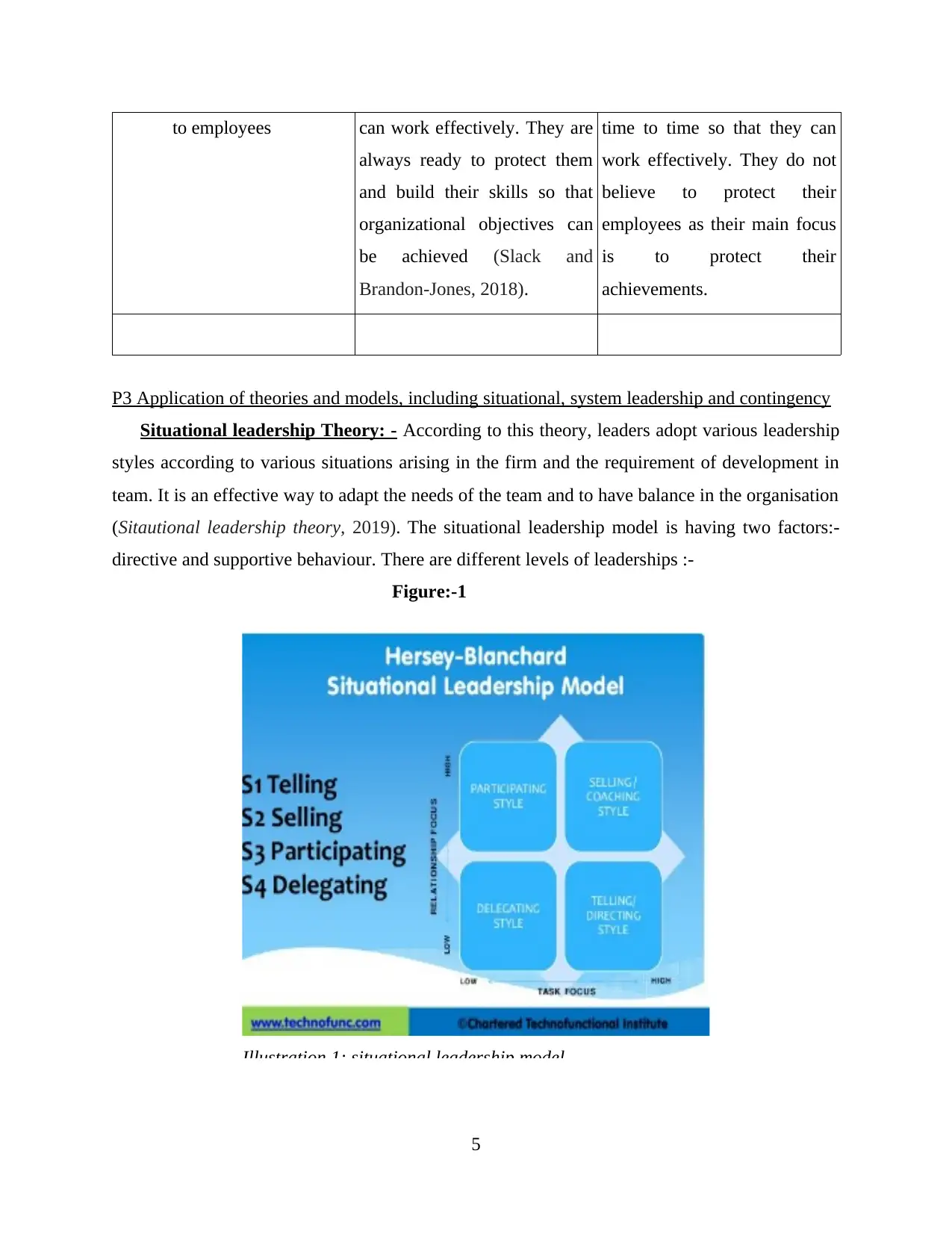
to employees can work effectively. They are
always ready to protect them
and build their skills so that
organizational objectives can
be achieved (Slack and
Brandon-Jones, 2018).
time to time so that they can
work effectively. They do not
believe to protect their
employees as their main focus
is to protect their
achievements.
P3 Application of theories and models, including situational, system leadership and contingency
Situational leadership Theory: - According to this theory, leaders adopt various leadership
styles according to various situations arising in the firm and the requirement of development in
team. It is an effective way to adapt the needs of the team and to have balance in the organisation
(Sitautional leadership theory, 2019). The situational leadership model is having two factors:-
directive and supportive behaviour. There are different levels of leaderships :-
Figure:-1
5
Illustration 1: situational leadership model
always ready to protect them
and build their skills so that
organizational objectives can
be achieved (Slack and
Brandon-Jones, 2018).
time to time so that they can
work effectively. They do not
believe to protect their
employees as their main focus
is to protect their
achievements.
P3 Application of theories and models, including situational, system leadership and contingency
Situational leadership Theory: - According to this theory, leaders adopt various leadership
styles according to various situations arising in the firm and the requirement of development in
team. It is an effective way to adapt the needs of the team and to have balance in the organisation
(Sitautional leadership theory, 2019). The situational leadership model is having two factors:-
directive and supportive behaviour. There are different levels of leaderships :-
Figure:-1
5
Illustration 1: situational leadership model
Paraphrase This Document
Need a fresh take? Get an instant paraphrase of this document with our AI Paraphraser
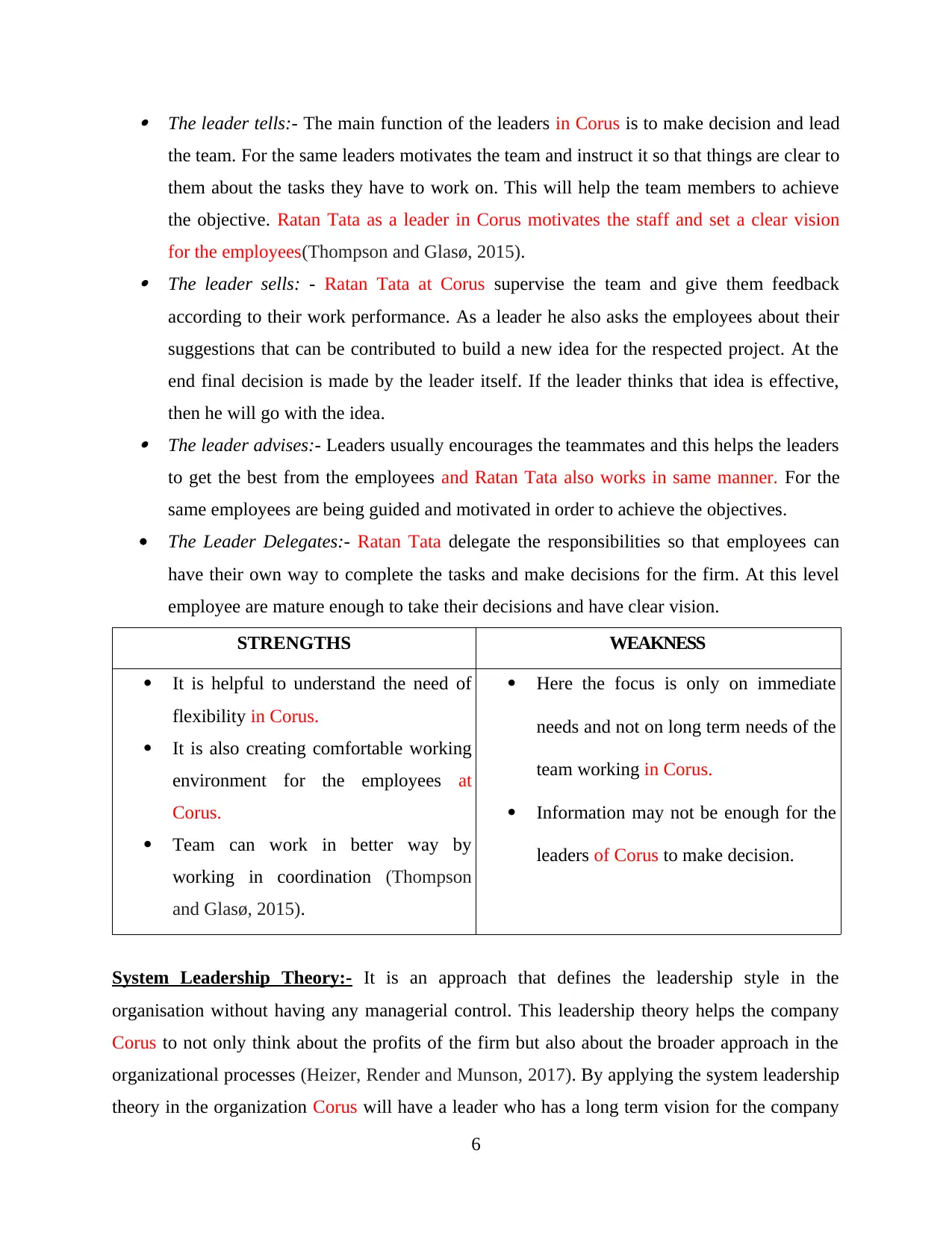
The leader tells:- The main function of the leaders in Corus is to make decision and lead
the team. For the same leaders motivates the team and instruct it so that things are clear to
them about the tasks they have to work on. This will help the team members to achieve
the objective. Ratan Tata as a leader in Corus motivates the staff and set a clear vision
for the employees(Thompson and Glasø, 2015). The leader sells: - Ratan Tata at Corus supervise the team and give them feedback
according to their work performance. As a leader he also asks the employees about their
suggestions that can be contributed to build a new idea for the respected project. At the
end final decision is made by the leader itself. If the leader thinks that idea is effective,
then he will go with the idea. The leader advises:- Leaders usually encourages the teammates and this helps the leaders
to get the best from the employees and Ratan Tata also works in same manner. For the
same employees are being guided and motivated in order to achieve the objectives.
The Leader Delegates:- Ratan Tata delegate the responsibilities so that employees can
have their own way to complete the tasks and make decisions for the firm. At this level
employee are mature enough to take their decisions and have clear vision.
STRENGTHS WEAKNESS
It is helpful to understand the need of
flexibility in Corus.
It is also creating comfortable working
environment for the employees at
Corus.
Team can work in better way by
working in coordination (Thompson
and Glasø, 2015).
Here the focus is only on immediate
needs and not on long term needs of the
team working in Corus.
Information may not be enough for the
leaders of Corus to make decision.
System Leadership Theory:- It is an approach that defines the leadership style in the
organisation without having any managerial control. This leadership theory helps the company
Corus to not only think about the profits of the firm but also about the broader approach in the
organizational processes (Heizer, Render and Munson, 2017). By applying the system leadership
theory in the organization Corus will have a leader who has a long term vision for the company
6
the team. For the same leaders motivates the team and instruct it so that things are clear to
them about the tasks they have to work on. This will help the team members to achieve
the objective. Ratan Tata as a leader in Corus motivates the staff and set a clear vision
for the employees(Thompson and Glasø, 2015). The leader sells: - Ratan Tata at Corus supervise the team and give them feedback
according to their work performance. As a leader he also asks the employees about their
suggestions that can be contributed to build a new idea for the respected project. At the
end final decision is made by the leader itself. If the leader thinks that idea is effective,
then he will go with the idea. The leader advises:- Leaders usually encourages the teammates and this helps the leaders
to get the best from the employees and Ratan Tata also works in same manner. For the
same employees are being guided and motivated in order to achieve the objectives.
The Leader Delegates:- Ratan Tata delegate the responsibilities so that employees can
have their own way to complete the tasks and make decisions for the firm. At this level
employee are mature enough to take their decisions and have clear vision.
STRENGTHS WEAKNESS
It is helpful to understand the need of
flexibility in Corus.
It is also creating comfortable working
environment for the employees at
Corus.
Team can work in better way by
working in coordination (Thompson
and Glasø, 2015).
Here the focus is only on immediate
needs and not on long term needs of the
team working in Corus.
Information may not be enough for the
leaders of Corus to make decision.
System Leadership Theory:- It is an approach that defines the leadership style in the
organisation without having any managerial control. This leadership theory helps the company
Corus to not only think about the profits of the firm but also about the broader approach in the
organizational processes (Heizer, Render and Munson, 2017). By applying the system leadership
theory in the organization Corus will have a leader who has a long term vision for the company
6
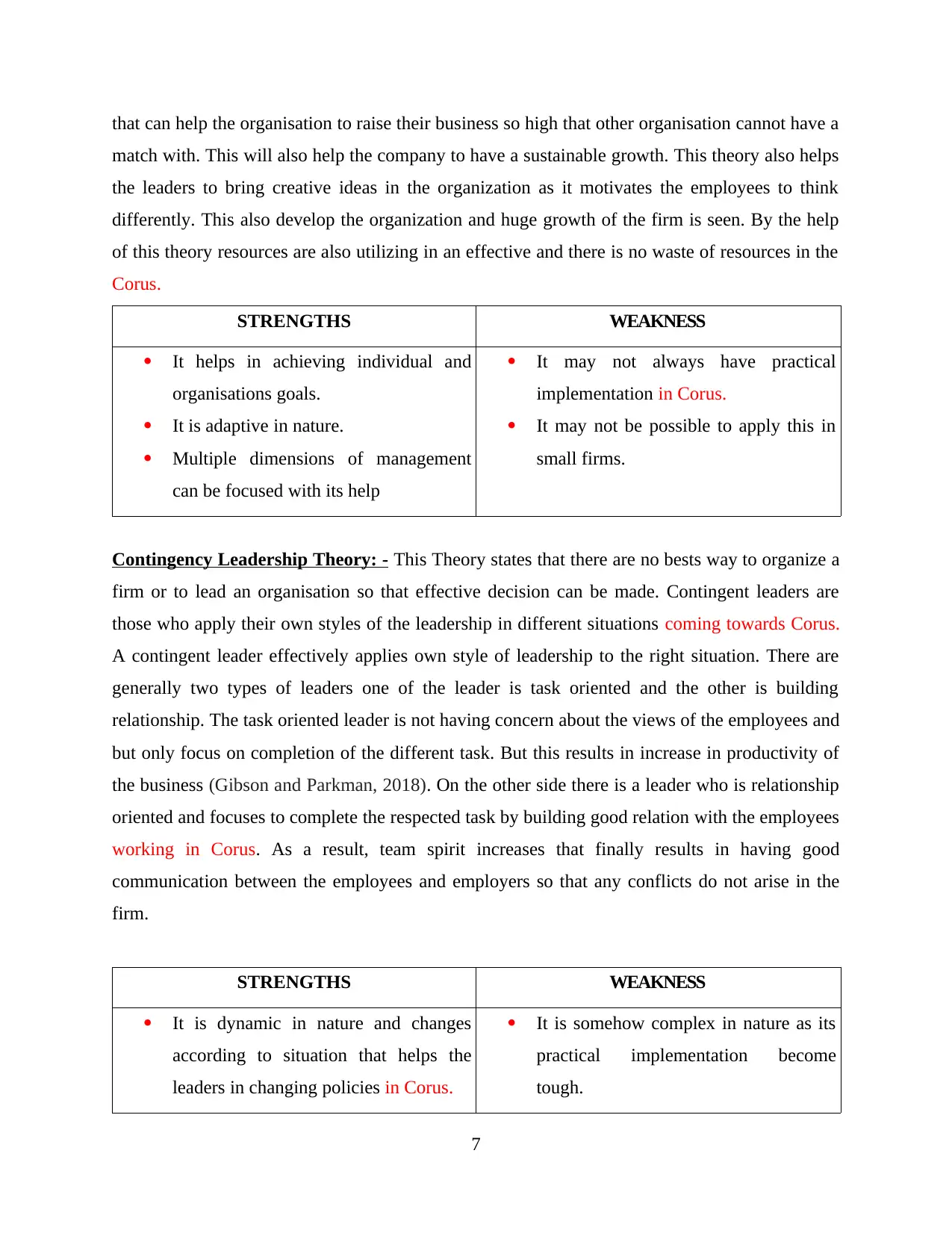
that can help the organisation to raise their business so high that other organisation cannot have a
match with. This will also help the company to have a sustainable growth. This theory also helps
the leaders to bring creative ideas in the organization as it motivates the employees to think
differently. This also develop the organization and huge growth of the firm is seen. By the help
of this theory resources are also utilizing in an effective and there is no waste of resources in the
Corus.
STRENGTHS WEAKNESS
It helps in achieving individual and
organisations goals.
It is adaptive in nature.
Multiple dimensions of management
can be focused with its help
It may not always have practical
implementation in Corus.
It may not be possible to apply this in
small firms.
Contingency Leadership Theory: - This Theory states that there are no bests way to organize a
firm or to lead an organisation so that effective decision can be made. Contingent leaders are
those who apply their own styles of the leadership in different situations coming towards Corus.
A contingent leader effectively applies own style of leadership to the right situation. There are
generally two types of leaders one of the leader is task oriented and the other is building
relationship. The task oriented leader is not having concern about the views of the employees and
but only focus on completion of the different task. But this results in increase in productivity of
the business (Gibson and Parkman, 2018). On the other side there is a leader who is relationship
oriented and focuses to complete the respected task by building good relation with the employees
working in Corus. As a result, team spirit increases that finally results in having good
communication between the employees and employers so that any conflicts do not arise in the
firm.
STRENGTHS WEAKNESS
It is dynamic in nature and changes
according to situation that helps the
leaders in changing policies in Corus.
It is somehow complex in nature as its
practical implementation become
tough.
7
match with. This will also help the company to have a sustainable growth. This theory also helps
the leaders to bring creative ideas in the organization as it motivates the employees to think
differently. This also develop the organization and huge growth of the firm is seen. By the help
of this theory resources are also utilizing in an effective and there is no waste of resources in the
Corus.
STRENGTHS WEAKNESS
It helps in achieving individual and
organisations goals.
It is adaptive in nature.
Multiple dimensions of management
can be focused with its help
It may not always have practical
implementation in Corus.
It may not be possible to apply this in
small firms.
Contingency Leadership Theory: - This Theory states that there are no bests way to organize a
firm or to lead an organisation so that effective decision can be made. Contingent leaders are
those who apply their own styles of the leadership in different situations coming towards Corus.
A contingent leader effectively applies own style of leadership to the right situation. There are
generally two types of leaders one of the leader is task oriented and the other is building
relationship. The task oriented leader is not having concern about the views of the employees and
but only focus on completion of the different task. But this results in increase in productivity of
the business (Gibson and Parkman, 2018). On the other side there is a leader who is relationship
oriented and focuses to complete the respected task by building good relation with the employees
working in Corus. As a result, team spirit increases that finally results in having good
communication between the employees and employers so that any conflicts do not arise in the
firm.
STRENGTHS WEAKNESS
It is dynamic in nature and changes
according to situation that helps the
leaders in changing policies in Corus.
It is somehow complex in nature as its
practical implementation become
tough.
7
⊘ This is a preview!⊘
Do you want full access?
Subscribe today to unlock all pages.

Trusted by 1+ million students worldwide
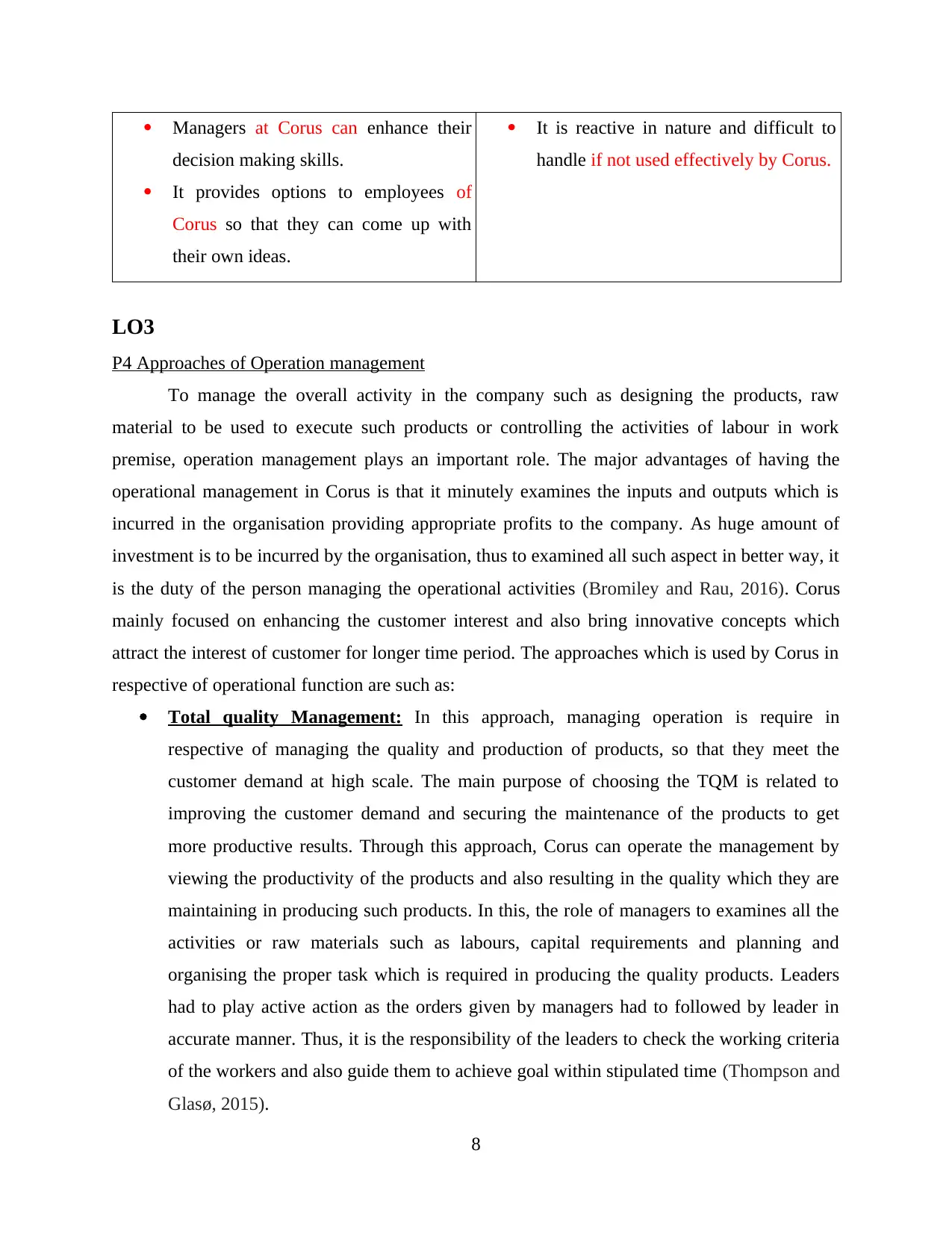
Managers at Corus can enhance their
decision making skills.
It provides options to employees of
Corus so that they can come up with
their own ideas.
It is reactive in nature and difficult to
handle if not used effectively by Corus.
LO3
P4 Approaches of Operation management
To manage the overall activity in the company such as designing the products, raw
material to be used to execute such products or controlling the activities of labour in work
premise, operation management plays an important role. The major advantages of having the
operational management in Corus is that it minutely examines the inputs and outputs which is
incurred in the organisation providing appropriate profits to the company. As huge amount of
investment is to be incurred by the organisation, thus to examined all such aspect in better way, it
is the duty of the person managing the operational activities (Bromiley and Rau, 2016). Corus
mainly focused on enhancing the customer interest and also bring innovative concepts which
attract the interest of customer for longer time period. The approaches which is used by Corus in
respective of operational function are such as:
Total quality Management: In this approach, managing operation is require in
respective of managing the quality and production of products, so that they meet the
customer demand at high scale. The main purpose of choosing the TQM is related to
improving the customer demand and securing the maintenance of the products to get
more productive results. Through this approach, Corus can operate the management by
viewing the productivity of the products and also resulting in the quality which they are
maintaining in producing such products. In this, the role of managers to examines all the
activities or raw materials such as labours, capital requirements and planning and
organising the proper task which is required in producing the quality products. Leaders
had to play active action as the orders given by managers had to followed by leader in
accurate manner. Thus, it is the responsibility of the leaders to check the working criteria
of the workers and also guide them to achieve goal within stipulated time (Thompson and
Glasø, 2015).
8
decision making skills.
It provides options to employees of
Corus so that they can come up with
their own ideas.
It is reactive in nature and difficult to
handle if not used effectively by Corus.
LO3
P4 Approaches of Operation management
To manage the overall activity in the company such as designing the products, raw
material to be used to execute such products or controlling the activities of labour in work
premise, operation management plays an important role. The major advantages of having the
operational management in Corus is that it minutely examines the inputs and outputs which is
incurred in the organisation providing appropriate profits to the company. As huge amount of
investment is to be incurred by the organisation, thus to examined all such aspect in better way, it
is the duty of the person managing the operational activities (Bromiley and Rau, 2016). Corus
mainly focused on enhancing the customer interest and also bring innovative concepts which
attract the interest of customer for longer time period. The approaches which is used by Corus in
respective of operational function are such as:
Total quality Management: In this approach, managing operation is require in
respective of managing the quality and production of products, so that they meet the
customer demand at high scale. The main purpose of choosing the TQM is related to
improving the customer demand and securing the maintenance of the products to get
more productive results. Through this approach, Corus can operate the management by
viewing the productivity of the products and also resulting in the quality which they are
maintaining in producing such products. In this, the role of managers to examines all the
activities or raw materials such as labours, capital requirements and planning and
organising the proper task which is required in producing the quality products. Leaders
had to play active action as the orders given by managers had to followed by leader in
accurate manner. Thus, it is the responsibility of the leaders to check the working criteria
of the workers and also guide them to achieve goal within stipulated time (Thompson and
Glasø, 2015).
8
Paraphrase This Document
Need a fresh take? Get an instant paraphrase of this document with our AI Paraphraser
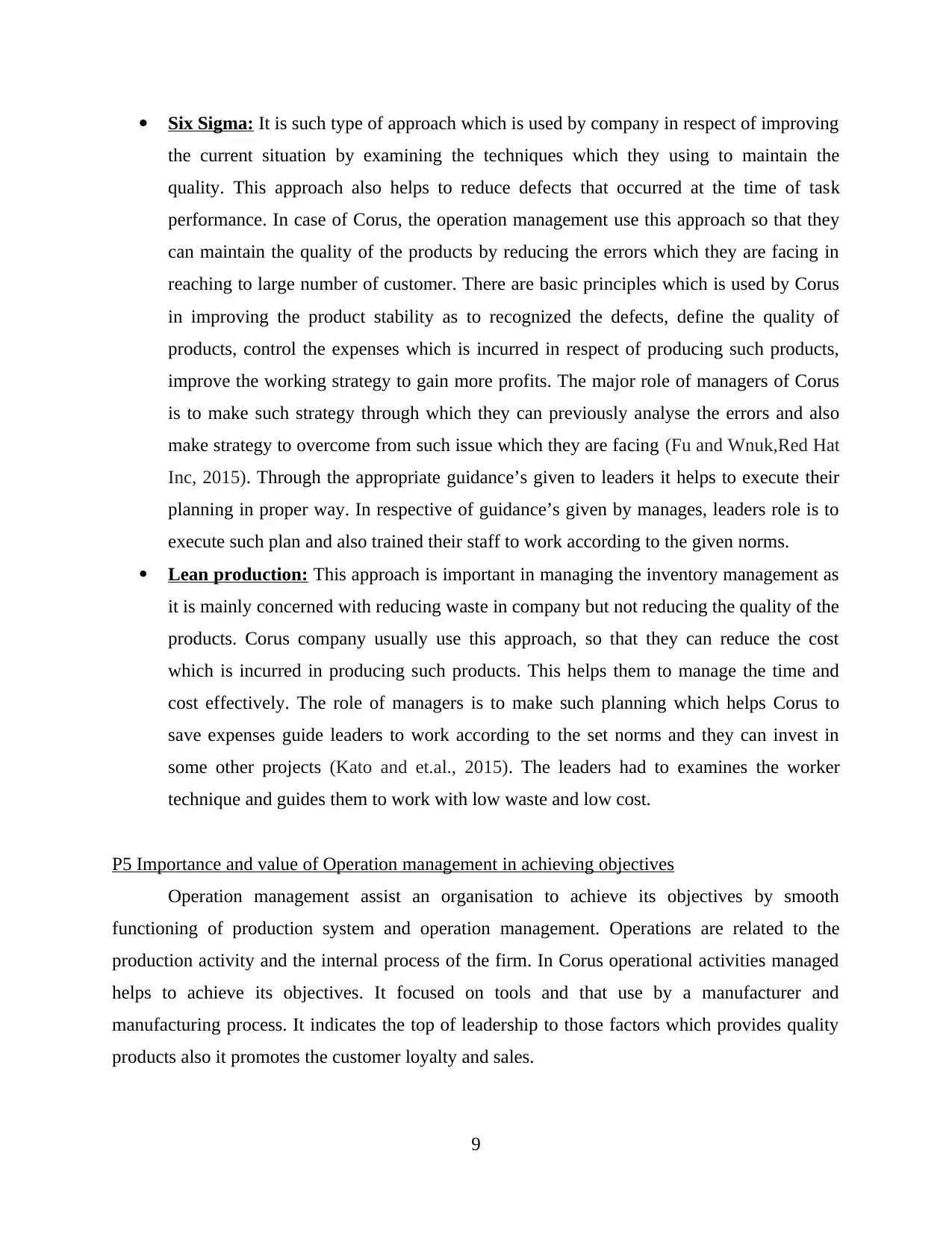
Six Sigma: It is such type of approach which is used by company in respect of improving
the current situation by examining the techniques which they using to maintain the
quality. This approach also helps to reduce defects that occurred at the time of task
performance. In case of Corus, the operation management use this approach so that they
can maintain the quality of the products by reducing the errors which they are facing in
reaching to large number of customer. There are basic principles which is used by Corus
in improving the product stability as to recognized the defects, define the quality of
products, control the expenses which is incurred in respect of producing such products,
improve the working strategy to gain more profits. The major role of managers of Corus
is to make such strategy through which they can previously analyse the errors and also
make strategy to overcome from such issue which they are facing (Fu and Wnuk,Red Hat
Inc, 2015). Through the appropriate guidance’s given to leaders it helps to execute their
planning in proper way. In respective of guidance’s given by manages, leaders role is to
execute such plan and also trained their staff to work according to the given norms.
Lean production: This approach is important in managing the inventory management as
it is mainly concerned with reducing waste in company but not reducing the quality of the
products. Corus company usually use this approach, so that they can reduce the cost
which is incurred in producing such products. This helps them to manage the time and
cost effectively. The role of managers is to make such planning which helps Corus to
save expenses guide leaders to work according to the set norms and they can invest in
some other projects (Kato and et.al., 2015). The leaders had to examines the worker
technique and guides them to work with low waste and low cost.
P5 Importance and value of Operation management in achieving objectives
Operation management assist an organisation to achieve its objectives by smooth
functioning of production system and operation management. Operations are related to the
production activity and the internal process of the firm. In Corus operational activities managed
helps to achieve its objectives. It focused on tools and that use by a manufacturer and
manufacturing process. It indicates the top of leadership to those factors which provides quality
products also it promotes the customer loyalty and sales.
9
the current situation by examining the techniques which they using to maintain the
quality. This approach also helps to reduce defects that occurred at the time of task
performance. In case of Corus, the operation management use this approach so that they
can maintain the quality of the products by reducing the errors which they are facing in
reaching to large number of customer. There are basic principles which is used by Corus
in improving the product stability as to recognized the defects, define the quality of
products, control the expenses which is incurred in respect of producing such products,
improve the working strategy to gain more profits. The major role of managers of Corus
is to make such strategy through which they can previously analyse the errors and also
make strategy to overcome from such issue which they are facing (Fu and Wnuk,Red Hat
Inc, 2015). Through the appropriate guidance’s given to leaders it helps to execute their
planning in proper way. In respective of guidance’s given by manages, leaders role is to
execute such plan and also trained their staff to work according to the given norms.
Lean production: This approach is important in managing the inventory management as
it is mainly concerned with reducing waste in company but not reducing the quality of the
products. Corus company usually use this approach, so that they can reduce the cost
which is incurred in producing such products. This helps them to manage the time and
cost effectively. The role of managers is to make such planning which helps Corus to
save expenses guide leaders to work according to the set norms and they can invest in
some other projects (Kato and et.al., 2015). The leaders had to examines the worker
technique and guides them to work with low waste and low cost.
P5 Importance and value of Operation management in achieving objectives
Operation management assist an organisation to achieve its objectives by smooth
functioning of production system and operation management. Operations are related to the
production activity and the internal process of the firm. In Corus operational activities managed
helps to achieve its objectives. It focused on tools and that use by a manufacturer and
manufacturing process. It indicates the top of leadership to those factors which provides quality
products also it promotes the customer loyalty and sales.
9
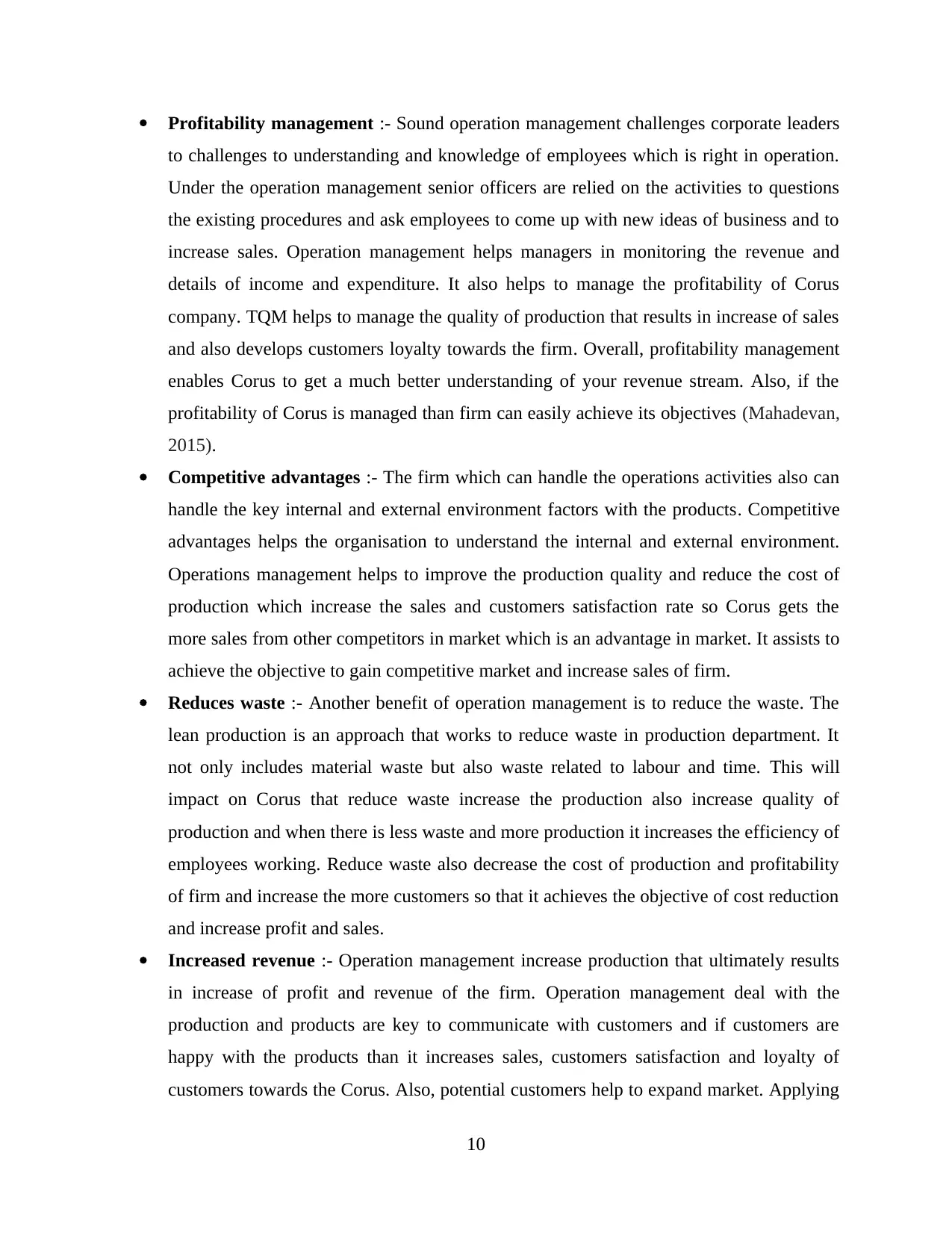
Profitability management :- Sound operation management challenges corporate leaders
to challenges to understanding and knowledge of employees which is right in operation.
Under the operation management senior officers are relied on the activities to questions
the existing procedures and ask employees to come up with new ideas of business and to
increase sales. Operation management helps managers in monitoring the revenue and
details of income and expenditure. It also helps to manage the profitability of Corus
company. TQM helps to manage the quality of production that results in increase of sales
and also develops customers loyalty towards the firm. Overall, profitability management
enables Corus to get a much better understanding of your revenue stream. Also, if the
profitability of Corus is managed than firm can easily achieve its objectives (Mahadevan,
2015).
Competitive advantages :- The firm which can handle the operations activities also can
handle the key internal and external environment factors with the products. Competitive
advantages helps the organisation to understand the internal and external environment.
Operations management helps to improve the production quality and reduce the cost of
production which increase the sales and customers satisfaction rate so Corus gets the
more sales from other competitors in market which is an advantage in market. It assists to
achieve the objective to gain competitive market and increase sales of firm.
Reduces waste :- Another benefit of operation management is to reduce the waste. The
lean production is an approach that works to reduce waste in production department. It
not only includes material waste but also waste related to labour and time. This will
impact on Corus that reduce waste increase the production also increase quality of
production and when there is less waste and more production it increases the efficiency of
employees working. Reduce waste also decrease the cost of production and profitability
of firm and increase the more customers so that it achieves the objective of cost reduction
and increase profit and sales.
Increased revenue :- Operation management increase production that ultimately results
in increase of profit and revenue of the firm. Operation management deal with the
production and products are key to communicate with customers and if customers are
happy with the products than it increases sales, customers satisfaction and loyalty of
customers towards the Corus. Also, potential customers help to expand market. Applying
10
to challenges to understanding and knowledge of employees which is right in operation.
Under the operation management senior officers are relied on the activities to questions
the existing procedures and ask employees to come up with new ideas of business and to
increase sales. Operation management helps managers in monitoring the revenue and
details of income and expenditure. It also helps to manage the profitability of Corus
company. TQM helps to manage the quality of production that results in increase of sales
and also develops customers loyalty towards the firm. Overall, profitability management
enables Corus to get a much better understanding of your revenue stream. Also, if the
profitability of Corus is managed than firm can easily achieve its objectives (Mahadevan,
2015).
Competitive advantages :- The firm which can handle the operations activities also can
handle the key internal and external environment factors with the products. Competitive
advantages helps the organisation to understand the internal and external environment.
Operations management helps to improve the production quality and reduce the cost of
production which increase the sales and customers satisfaction rate so Corus gets the
more sales from other competitors in market which is an advantage in market. It assists to
achieve the objective to gain competitive market and increase sales of firm.
Reduces waste :- Another benefit of operation management is to reduce the waste. The
lean production is an approach that works to reduce waste in production department. It
not only includes material waste but also waste related to labour and time. This will
impact on Corus that reduce waste increase the production also increase quality of
production and when there is less waste and more production it increases the efficiency of
employees working. Reduce waste also decrease the cost of production and profitability
of firm and increase the more customers so that it achieves the objective of cost reduction
and increase profit and sales.
Increased revenue :- Operation management increase production that ultimately results
in increase of profit and revenue of the firm. Operation management deal with the
production and products are key to communicate with customers and if customers are
happy with the products than it increases sales, customers satisfaction and loyalty of
customers towards the Corus. Also, potential customers help to expand market. Applying
10
⊘ This is a preview!⊘
Do you want full access?
Subscribe today to unlock all pages.

Trusted by 1+ million students worldwide
1 out of 17
Related Documents
Your All-in-One AI-Powered Toolkit for Academic Success.
+13062052269
info@desklib.com
Available 24*7 on WhatsApp / Email
![[object Object]](/_next/static/media/star-bottom.7253800d.svg)
Unlock your academic potential
Copyright © 2020–2025 A2Z Services. All Rights Reserved. Developed and managed by ZUCOL.





